
Text © Dr Claudio Littardi

English translation by Mario Beltramini
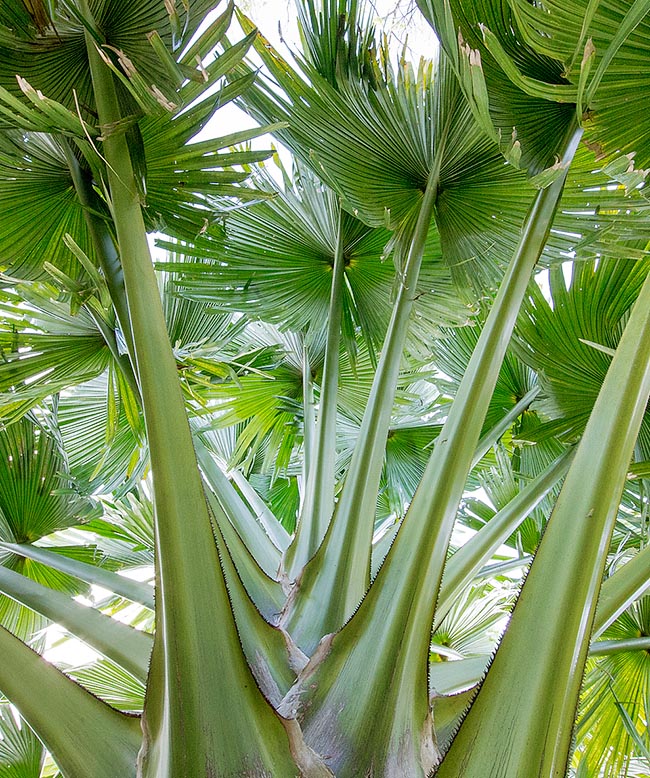
Majestic Corypha taliera. The palms represent an old form of life, as witnessed by fossils from the Upper Cretaceus and which are distributed at much more northern latitudes than those of the present species © Giuseppe Mazza
The palms belong to the Arecaceae family and are a monophyletic group that occupies a prominent place among the Plantae, by the well defined systematic position as well as for the particular look and posture of the species (Fenaroli 1949).
The palms are monocotyledonous arboreal, longevous and with permanent primary growth, unique characteristics that mark them and have since always exercised a singular charm in the world of botany.
The palms represent an ancient form of life, as do witness fossil finds dating from the Late Cretaceous and with a distribution at latitudes much more to north compared to today. Fossil finds and pollens of tropical species have been found also in Europe.
How many are the known palms
The most recent and generally accepted classification of the family of the Arecaceae or Palms refers to Genera Palmarum : The evolution and classification of palms, by J. Dransfield et N. Uhl, (Kew Publishing, 2008), that describes 183 genera and about 2700 species.
Geographic distribution
The natural distribution of the palms is mainly tropical, even if several species grow in subtropical areas (Henderson et al. 1995).
The most boreal species is Chamaerops humilis L., that in Europe is reported at 44° lat. North (Portofino) and is diffused in all western Mediterranean, from south of Portugal to Malta and from Morocco to Lybia. On the American continent the northernmost palms are Washingtonia filifera H.Wendl. in California and Rapidophyllum hystrix H.Wendl. & Drude in South Carolina, Alabama and Georgia. In the Austral sector we find the species Rhopalostylis sapida H.Wendl. & Drude that occupies the extreme limit of Chatham Island, in New Zealand (44° lat. South).
As for the altitude we can find palms growing naturally at the sea level, as well as in hilly or mountainous zones. The species holding the record of growing at the highest altitude is Ceroxylon utile Wendl., that we find on the Andes at 4000 m above sea level. Not far behind species like Calamus gibbsianus Becc. and Pinanga capitata Becc. growing on the mountain Kinabalu, in Borneo, at more than 3000 m. Same is for Trachycarpus martianus H.Wendl., characteristic palm of Himalaya, living up to 2400 meters. However, there are many other palms that we may find in habitats of mountain woods besides the 2000 m mark, and among these we note Caryota maxima Blume ex Mart., Dypsis spp. and Hyospathe spp.
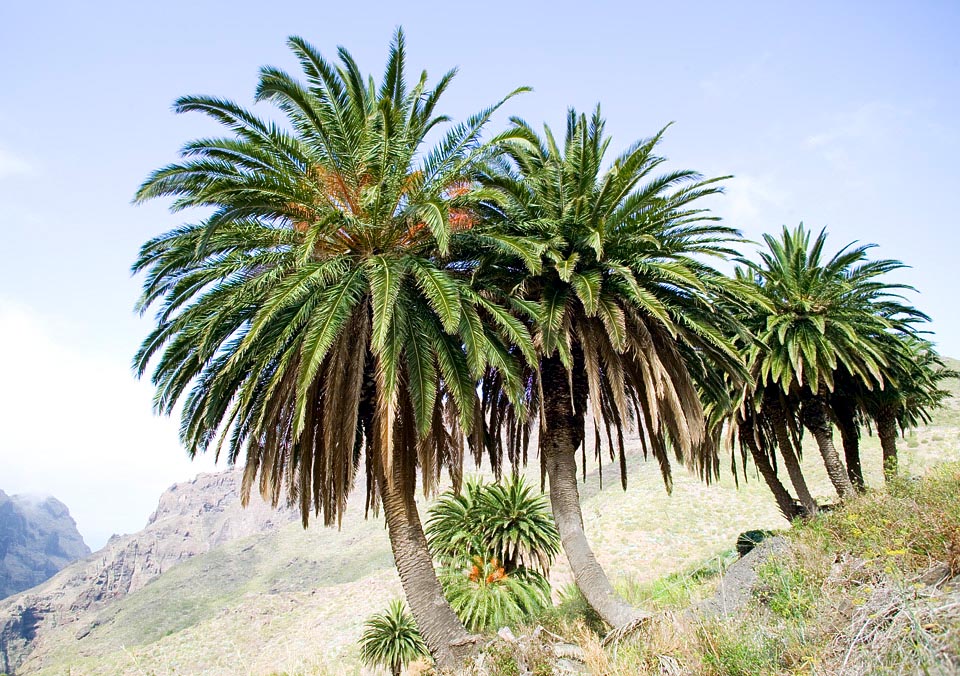
Phoenix canariensis in its natural habitat in the Canaries. In the world of the palms the genus Calamus is the one better represented with about 370 species and a pantropical diffusion. Other genera with few species have instead a very vast diffusion, like for instance the Borassus, the Phoenix and the Raphia © Giuseppe Mazza
Geographic distribution of the genera
Though the palms show a great diffusion in the tropical regions, we can note that most of them have a limited distribution, with different monospecific genera or with few species.
The genus Calamus is the most represented one, with about 370 species and pantropical diffusion. Some genera, with few species, have worldwide diffusion, such as Borassus, Phoenix and Raphia, whilst other genera, with numerous species, occupy restricted areas. To this group belong Licuala and Pinanga with more than 100 species and dense populations in Malaysia and New Guinea. Same situation we see for the genus Chamaedorea in Central and South America.
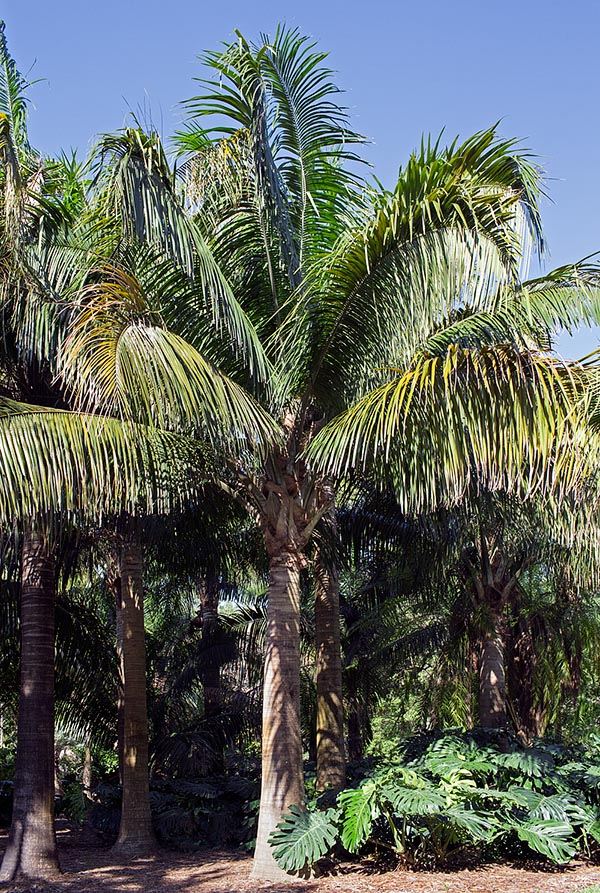
Attalea crassispatha is endemic to a limited area in the south-western part of Haiti, making it presently one of the absolute rarest palms. Nowadays, several species are risking extinction in nature © Giuseppe Mazza
Endemisms
Among the palms are not missing endemisms and numerous are those localized in small areas, limited to specific niches and in different habitats. Only in the Lord Howe islands, in the Pacific Ocean, south east Australia, we count three genera and four endemic species. Of these, two grow along the coast, another is met at medium altitudes, whilst the last one lives on the mountain summits of these islands. Among the insular endemisms, the Fiji Islands boasts ten genera and 22 species, whilst in New Caledonia live 17 genera and thirty species. Similar situations are found in New Guinea and in Madagascar.
Where the palms grow
Most of the palms live in the humid tropical forest, where some of them tower beyond the canopy, whilst others mix with the rich vegetation or live under foliage in shady conditions.
In the humid forest are diffused the climbing palms that, starting from the roots anchored to the soil, develop a long trunk, and utilizing as support other palms or trees, go up, towards the light. Extensive colonies of palms grow in open prairies or in savannahs, and many of these manifest a marked resistance to drought and tolerate the damages caused by frequent fires.
These huge concentrations of palms are usually represented by one species only, like for the genera Borassus, Livistona, Phoenix and Raphia. Instead, for the palms growing in forest, are not reported major accumulations, as we see a high number of different species in restricted areas.
Phoenix paludosa Roxb. and Raphia taedigera Mart. occupy in dense colonies, open and humid zones, even swampy. Soils submitted to periodical flooding phenomena can host palms that, with the roots, explore deep layers of the soil and absorb the ground water in periods of heavy drought.
At evolutionary level some palms have developed astonishing strategies for the research and conservation of the water, but cannot however survive to long periods of drought. The same date palm, Phoenix dactylifera L., which grows in the most desolate desert, may live only if drawing ground water.
Few palms tolerate the great cold and the snow, but Nannorrhops ritchieana Aitch. of the mountains of Afghanistan and Trachycarpus of Himalaya spend the winter under the snow.
In the great forests the palms are usually competing with the trees to reach the light above, and with their stalk emerging towards the sky offer an extraordinary landscaping profile.
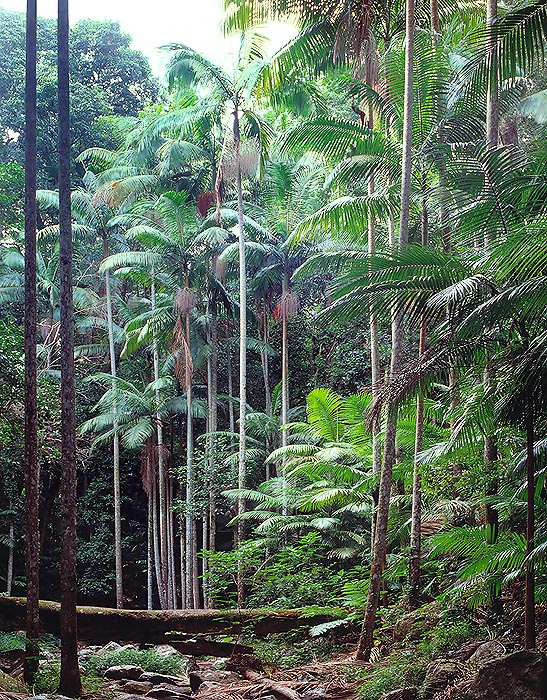
Archontophoenix cunninghamiana in a forest of Queensland in Australia. Most of the palms grow in the humid tropical forest where some stand out luxuriantly from the canopy © Giuseppe Mazza
Among these palms, tall and slender distinguish Beccariophoenix madagascariensis Jum. & H.Perrier, Borassus spp., Ceroxylon spp. and Livistona saribus Merr. ex A.Chev.
Many palms grow naturally in the shadiest layers of the forest and among these we note Aiphanes spp., Calyptrocalyx spp., Chamaedorea spp., Dypsis spp., Geonoma spp., Licuala spp., Rhapis spp. and Wallichia spp.
Only one species grows in mangroves, the Nypa fruticans Wurmb, present at the estuaries of the rivers of Asia and on the eastern coasts of the Pacific Ocean, forming vast colonies. It settles on the low and muddy bottoms and entrusts to the currents the dispersion of the fruits.
At the limits of the mangroves grow other palms such as Copernicia gigas Ekman ex Burret, Licuala paludosa Griff. and Phoenix paludosa Roxb. Other palms tolerate well the sandy and salty soils along the coasts.
They are palms equipped with roots capable to absorb water in depth and tolerate the strong winds and the sea spray. Among these Cocos nucifera L., Allagoptera arenaria Kuntze, Allagoptera brevicalyx M. Moraes, Pseudophoenix sargentii H. Wendl and Thrinax radiata Lodd.
The palms occupy also areas subjected to periodical flooding and have a rheophytic behaviour. They are characterized by usually narrow and thin leaves, probably to facilitate the flow of the rushing waters. Among these Chamaedorea cataractarum Mart. of Central America and Pinanga of Borneo.
Also aquatic palms do exist, such as Ravenea musicalis Beentje, of Madagascar, that grows in the riverbeds. The seeds germinate in the fruit that, once ripe, falls in the water and continue the germination on the bottom of the river. The leaves are submerged and can anchor to the bottom. The palms cannot tolerate the life in zones having no water and the extreme condition requires however the presence of ground water in the zone explored by the roots. Among these the date palms Phoenix dactylifera L. and Livistona carinensis J.Dransf. & N.W.Uhl that grows in the oases of Arabia and Somalia and Medemia argun, between Egypt and Sudan. On the American continent, between Mexico and USA, the palms better tolerating the drought are Washingtonia, Brahea and Sabal.
Curiosities of the palms
The palms, with their particular organizational and biological structure reach a series of records recognized in the vegetal world. Belongs to Jubaea chilensis Baill., the primacy of the widest stem obtained through primary growth, as well developed specimens can exceed the metre of diameter.
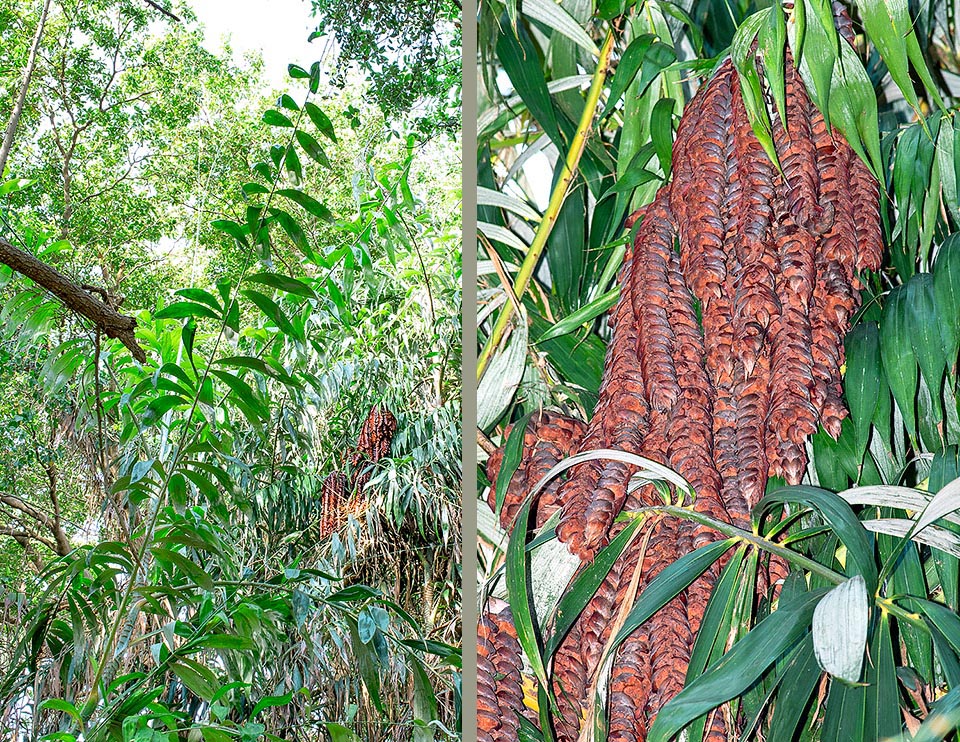
Native to South-East Asia, Plectocomia elongata is an imposing climbing palm with stems that reach a length from 30 to 50 m creeping on the ground like snakes until they do not find a solid support. The rachis extends beyond the lanceolate leaflets in a tendril, even 3 m long, armed of hooked curved spines, for anchoring on the branches of the trees. On the right, detail of the inflorescence, up to 2 m long. The flowers are covered by overlying concave bracts of brown-reddish colour © Giuseppe Mazza
In the same time, in respect to the majestic palm of Chile we note the smallest one, Syagrus lilliputiana Becc. of Paraguay, that is about 10 cm tall when adult.
Among the small palms we mention Chamaedorea stenocarpa Standl. & Steyerm. and Chamaedorea pygmaea H.Wendl. of the South American continent, which usually do not exceed 50 cm of height. In contrast with the small palms are opposed the wax palm Ceroxylon quindiuense H. Wendl. and Ceroxylon alpinum Bonpl. that can be more than 60 m tall.
The aerial stem, not ramified and longest is held, instead, by the climbing palms Calamus, which may reach the 200 m.
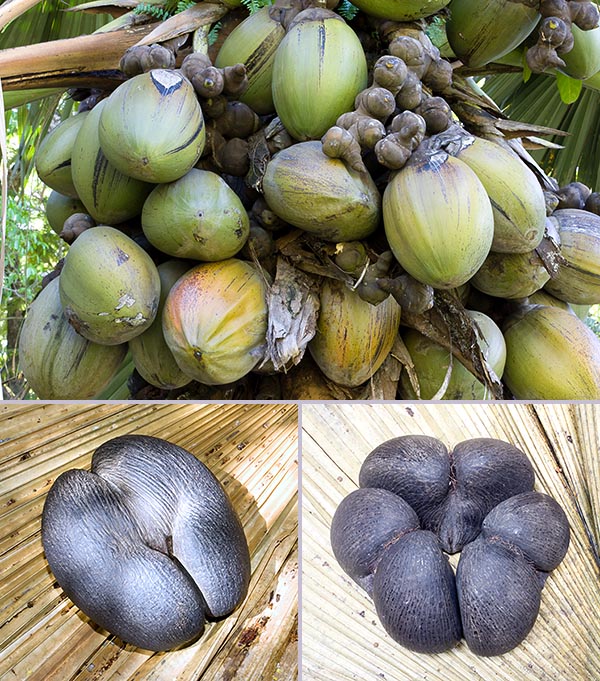
In the world of palms the biggest and most astonishing seed is from Lodoicea maldivica with a weight varying from 10 to 25 kg. The fruit can contain up to three seeds and may reach 45 k © Giuseppe Mazza
This is a length that exceeds the height of the trees traditionally taller, but the trunk of the Calamus is not self-sustaining and sneaks between the branches of other trees till it reaches the thick vegetation of the canopy.
Corypha umbraculifera L. holds the record of the biggest inflorescence. It is a hapaxanthic palm, that is with terminal paniculate inflorescence, which develops from the apex previously vegetative. The overall height of the inflorescence may exceed the 8 m and may present up to four orders of ramifications. The total estimated number of flower is about 20 millions.
The biggest seed is from Lodoicea maldivica Pers., whose weight varies from 10 to 25 kg. The fruit can contain up to three seeds and can reach the 45 kg. The living trees are the easiest trees to transplant.
The trunk of the palm is able to store a huge quantity from available water and has a great capacity to produce new roots compare to the base of the trunk. On these peculiarities are based horticultural practices that see transplanting palms of big dimensions such as Washingtonia, Sabal, Chamaerops and Phoenix. Conversely, belongs to Raphia regalis Becc. the record of length for a pinnate leaf that, in some instances, can exceed the 20 metres of length. Among the palmate leaves the biggest is found on the Corypha umbraculifera L. that reaches the 8 m diameter with a petiole about 5 m. Similar dimensions are reached also by Lodoicea maldivica Pers.
Morphological characters of the palms
Roots
The roots of the palms have form and structure different in respect to those of the arboreal dicotyledons, even if accomplishing the same duties. The basic functions are those of nourishing the palm, anchoring it to the soil, storing reserve nutrients and establishing symbiotic relations with mushrooms from the substratum.
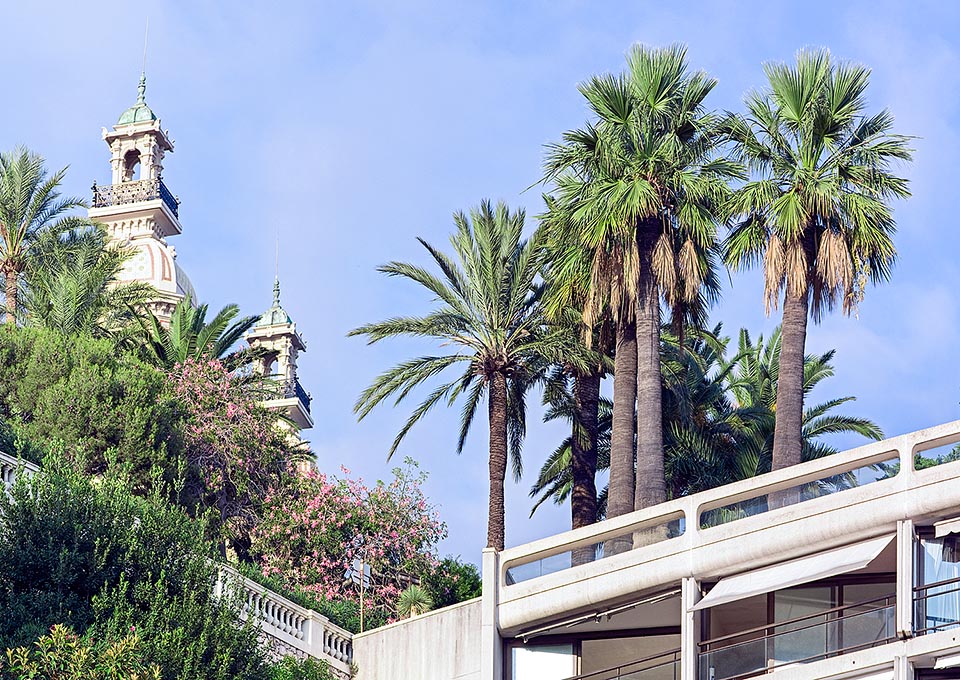
Without solid roots these palms, growing in a shallow 60 cm of soil on the Terraces of the Monte Carlo Casino, would have fallen a long time ago © Giuseppe Mazza
The roots of the palms are fasciculate, fibrous and fleshy, and, once absorbed the nutrients and the water, send them over as a coarse lymph to the stalk. In turn the roots receive from the leaves the elaborated lymph that reaches the rooting tips.
The roots emerge from the basal bulb which is the continuation of the stem in the soil. The basal bulb can reach up to one metre in depth or, when located outside, rise over the roots, depending on the species. Usually the roots are just an underground part of the stem, even if in many cases we note aerial emissions, external and well visible, as with Cryosophila williamsii P.H. Allen. In other cases, roots may emerge from under the cortex, along the stipe and develop only in case of disturbances (burying or damage). Some palms can produce roots from the stem, over the ground, as is the case of the date palm Phoenix dactylifera L. In some instances and in individuals having an advanced age, they may appear at more than 10 m from the soil and grow hidden among the bark and the pericycle.
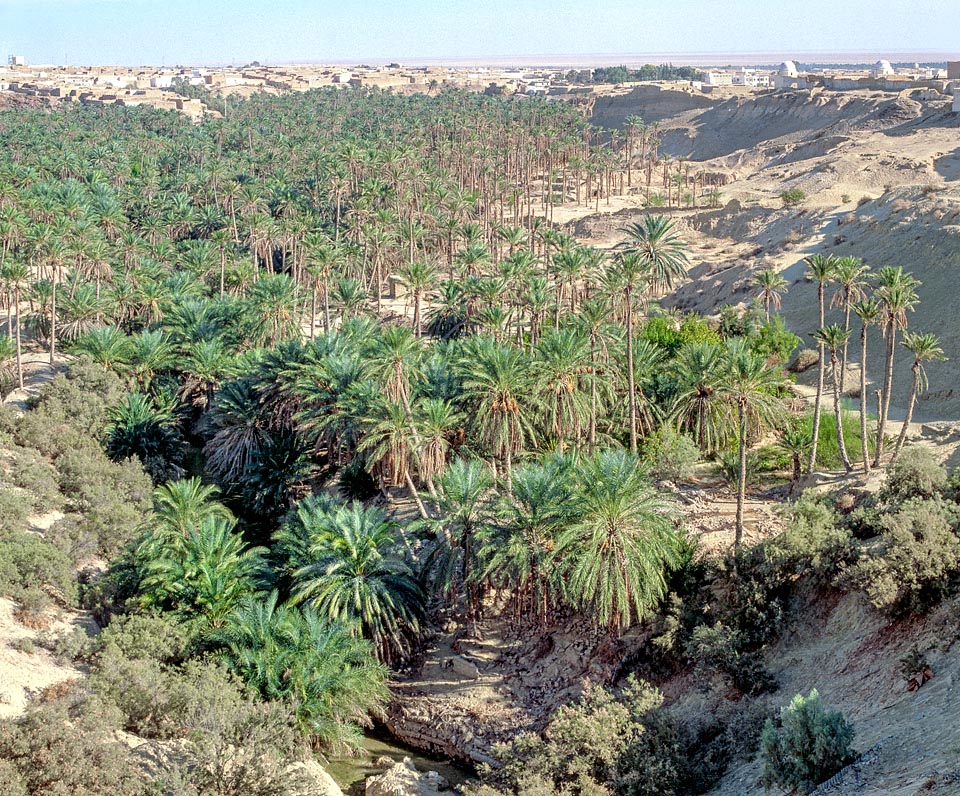
Phoenix dactylifera in the Nefta oasis (Tunisia). The roots of the plant reach the water present underground © Giuseppe Mazza
With a progressive growth, the rooting apparatus expands with a series of primary roots from which, following a hierarchical order, depart roots of second, third and fourth order. Also exist tertiary roots, with a further lower thickness and with an ascending and descending direction, but always with an insertion that begins perpendicularly.
All the roots present, in their terminal part, very close to the rooting cap, a clear or tending to white zone, not lignified, a few millimetres long, through which is realized the absorption of water and minerals and organic elements. The rooting exploration is influenced by the nature and by the hydrology of the substratum. The primary roots of Euterpe oleracea Mart. can extend up to 40 metres away from the main stalk. The rooting hairs are absent, but the absorption is facilitated by the small dimensions of the roots of lesser order and by their high number.
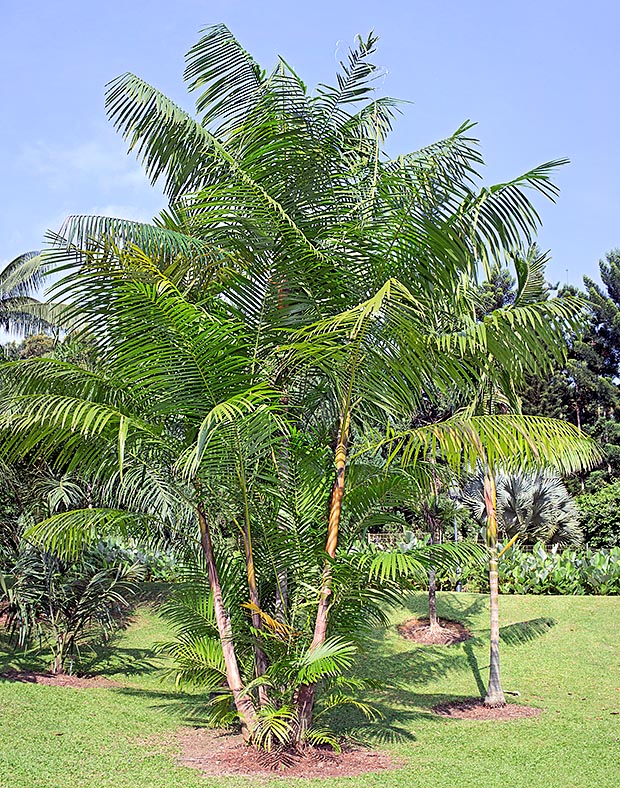
The primary roots of Euterpe oleracea can extend up to 40 m away from the main stem for water and anchor © Giuseppe Mazza
Of great ecological importance is the capacity to regenerate after having suffered damage. The regeneration may come from the emission of new roots as well as from ramifications departing in the proximity of the cut part, but the different regenerative responses vary depending on the species. In the case of Roystonea and Syargus, greater is the length from the point of insertion at the cut extremity, greater are the probabilities of ramifications. Some roots are equipped with pneumatodes, tissues that have the task of oxygenating the submerged roots of species belonging to the genera Phoenix, Metroxylon and Raphia.
The internal structure of the roots of the palms is formed by two clearly differentiated parts, the cortical zone and the medullar zone. This last hosts the conducting vessels. In the medulla we distinguish two parts: the pericycle, outermost, and the conducting vessels, in central position.
In the date palm the rooting bark has three zones. The outermost part, epidermis or rhizodermis, shows a wrinkled and irregular structure, of earthy brown colour, is rich of suberin that acts as insulating substance. The cortical parenchyma, that forms most of the bark, occupies an intermediate position, is formed by cells and fibres arranged to form great spaces, giving to the tissue a spongy look. Finally, we have the innermost zone of the bark or endodermis, which indicates a very precise separation between the bark itself and the medulla.
From the rooting pericycle, that keeps a meristematic character, generate the branches of the secondary, tertiary, etc. roots. The conducting vessels of rooting xylem and phloem merge forming conducting bundles that are surrounded by fibres of sclerenchymatous tissue. The two types of conducting vessels are arranged radially. The vessels of xylem carry the coarse lymph and have a bigger size, are located in the central zone of the medulla and reduce their own diameter gradually as they are moved towards the centre. The vessels of phloem, that distribute the elaborated lymph, are smaller than those of the xylem and occupy the zone turned towards the pericycle.
The growth of the root tends to be continuous and does not interrupt, unless the temperature is not very cold or the soil extremely dry or asphyxiated. The period of growth varies depending on the species, on the habitats, and in particular on the soils and the overall environmental conditions.
Planting of a palm requires interring at the level of the collar. Some palms bear a greater interring, but this does not facilitate the process of vegetative restart and, for some species, it may even cause the death of the specimen.
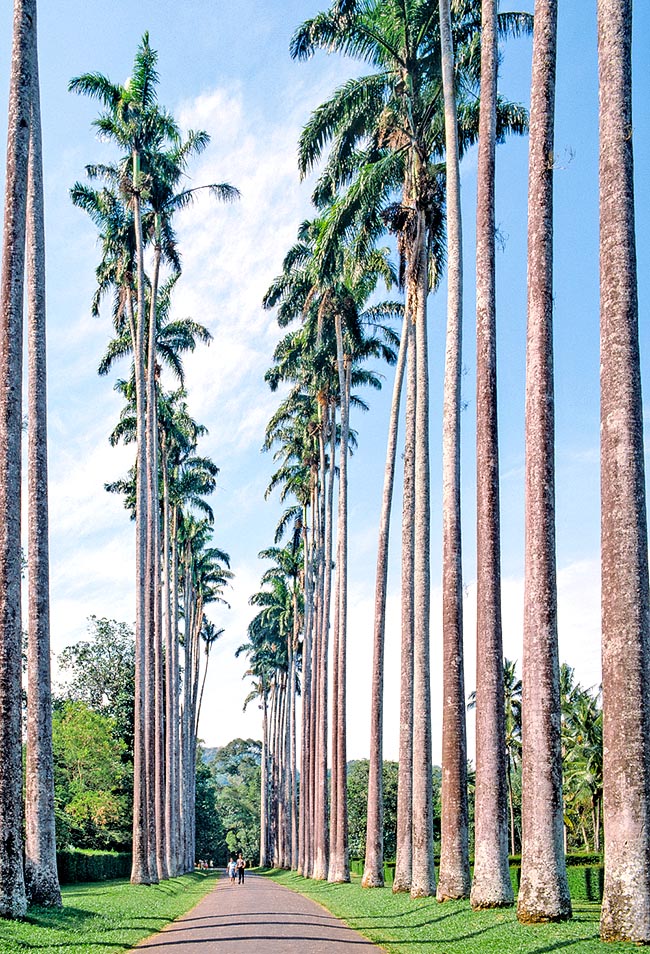
Majestic avenue of Roystonea oleracea in the Botanical Gardens of Peradeniya in Kandy (Sri Lanka). The stipe of the palms, in some cases reaching 60 m, is usually single, enlarged at the base, fibrous, full, cylindrical and tapered © Giuseppe Mazza
From the biomechanical point of view, we have to add that the rooting system of the palms is extremely effective, very extensive and is characterized by a high speed and capacity of regeneration. For these reasons it is very rare that the fall of adult palms occurs as a consequence of the loss of resistance or stability of the rooting system (dishing). The image of the palms whipped by hurricanes is an example known by all.
Stem
The stem of the palms has many characteristics in common with those of the trunk of the arboreal Dicotyledons. It is formed by lignified elements, is solid, can raise the foliar crown up to heights of 60 metres (Ceroxylon ceriferum Pittier) and has the same functions as the trunk of the trees belonging to the Dicotyledons. The functions of the stem are to sustain and raise the foliar crown exposing it at the best to the solar light, to serve as element of union in the conduction between the rooting apparatus and the leaves and to store the reserve substances, such as starch and water.
It differs on structure, composition and growing modality. The stem of the palms usually is single, enlarged at the base, fibrous, full, cylindrical and tapered. As we have already noted exist also palms with multiple stems. In some, may get out sprouts from the base and along the stem itself.
We can find ramified palms, even if this is less common. Exist also palms with climbing, underground and aquatic stems. The surface of the stem can show different forms: smooth, with remains of the base of the leaves woven with fibres, spines or segmentations similar to bamboos. Usually, with the fall of the leaves remains on the stem the mark of the scar left by the petiole.
In the transversal section of the stem appear 3 clearly differentiated zones: bark – pericycle (very thin) – medulla. The palms do not present secondary change and do not have rings of growth.
In the central part appears a more “soft” zone, called medulla, formed by a huge number of conducting vessels that go longitudinally through the interior of the stem. The vessels are wrapped in casings of sclerenchymatous fibres, immersed in a mass formed mainly by parenchymatous cells. The fibrovascular fascicles have inside them vessels of xylem and phloem that take care of the conduction of the raw and elaborate lymph.
The medullar area is completed by masses of specialized cells, among which are evident particular cells containing siliceous concretions of organic origin, that have such functions as reinforcing the structural and defensive resistance. These siliceous bodies are responsible of the fact that the cutting tools, after working on the tissues of palm, loose rapidly their sharpening.
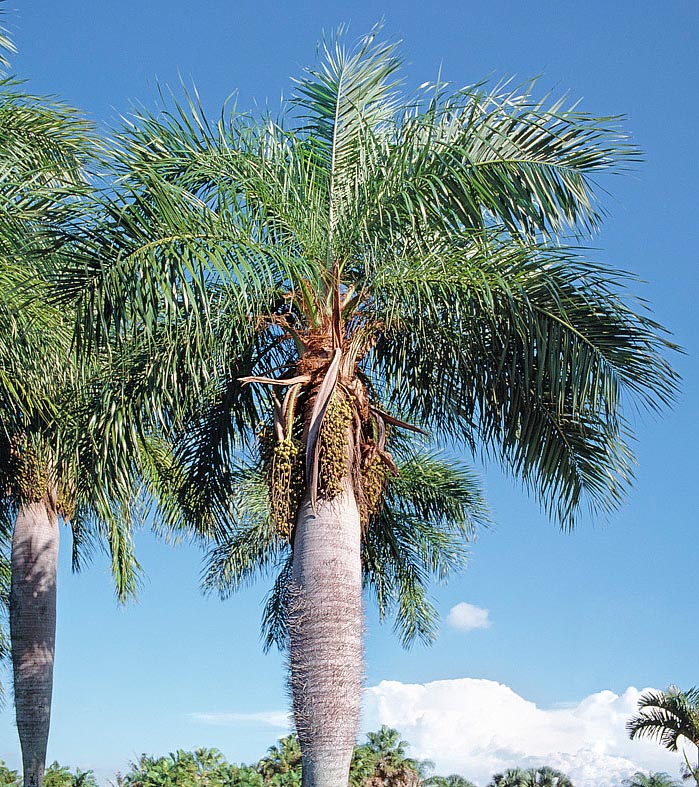
Acrocomia crispa. The stem can have swellings with defensive spines in order to store the water © Giuseppe Mazza
Abundant are the parenchymatous cells specialized in the accumulation of the reserve substances. Also, appear cells rich of tannins, responsible for the protection from the external aggressions, distributed all over the plant, but in the roots. This protection is active against the fungi and especially against the aggressions of the herbivores, seen that tannins confer a sour and unpleasant taste to the tissues. The tannins render less putrescible the protein substances, from this comes the resistance to the development of marcescences, rots and alterations of the trunk caused by fungi.
The outer part of the stem, improperly called bark, is formed by a cortical layer of variable thickness. The bark is mostly formed by the lignified residues of the fibrovascular bundles that head towards the leaf. The ring separating the bark from the medulla is called pericycle. It is a thin membrane, a few millimetres in thickness. More lignified fibrous bundles towards the outer part confer the stem the consistency and the strength necessary to contain the medulla and to resist the aggressions of the atmospheric agents. In this part are located also layers of cells that keep a certain meristematic character which, occasionally in some species, may develop roots (Phoenix dactylifera L.). In the longitudinal section of the stem of the palms, at the level of the medulla, the conductor bundles are intimately intertwined and in a sprawled way united ones to the others. In this way is built an extremely efficient net that allows in the entire stem a longitudinal and transversal conduction of the internal fluids (raw and elaborate lymph). This explains why when a stem suffers from a strong shrinkage of physical or pathological origine, the palms can continue to show a vigorous and brilliant foliage.
The stems of the palms do not heal the wounds because they do not have secondary change and do not generate reaction tissues. We must always avoid causing damage to the stem and therefore it is not convenient to use crampons for the ascent while pruning. The false growth in thickness that some species of palms present, especially at the base, is due to the capacity to produce a cellular swelling and the consequent thickening of the parenchymatous tissues, with increase of the overall volume. The narrowing that can be observed in some trunks of palm is usually due to nutritional and physiological stresses or to drastic cuts of leaves, pathologies or bad environmental conditions. In some cases they can indicate a point of fragility that must be evaluated at biomechanical level and kept under observation.
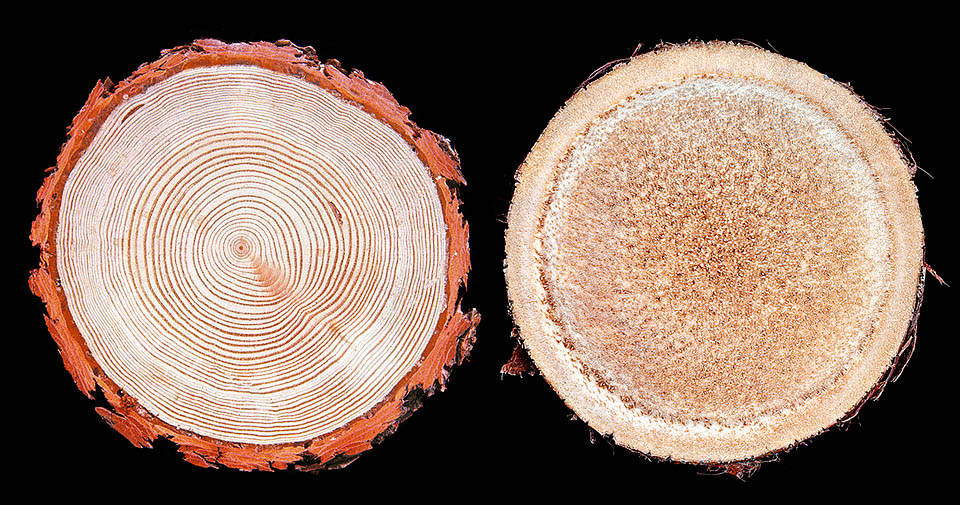
Stem vs stipe, Larix decidua compared to Washingtonia robusta. We note the absence of growth rings and of a real bark in the palm, here formed by the lignified remnants of the bundles that fed the leaves. The lymph does flow in the medulla, with a punctiform appearance, instead of the autumnal sapwood in true woods © Giuseppe Mazza
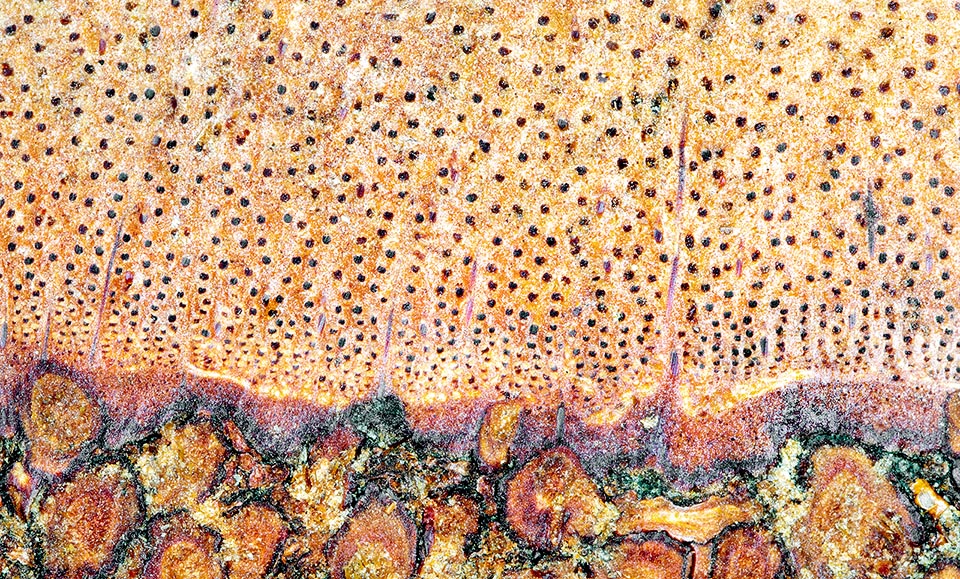
Enlarged section at root level form Phoenix canariensis. We clearly see the distribution of the fibrovascular bundles dispersed in the central medulla concentrating increasingly towards the peripheral zone where they lignify, solidifying the trunk. Below we note the sectioned root. The structure, in small, is the same as the stem, with tiny fibrovascular bundles. The dark lines, perpendicular to the contour, are the horizontal conductors starting from the roots and feeding the plant vascular system © Giuseppe Mazza
Leaves
The leaves of the palm form a crown in the upper part of the stem. Their basic function is making photosynthesis, starting from the raw lymph coming from the roots, intercepting the CO2 of the atmosphere through the stomata and exploiting the solar energy. They store also reserve nutrients and contribute to the hormonal control of the plant.
The leaves emerge from the apical meristem of the stem, in vertical position, following a helicoidal pattern. The importance of the leaves in the classification of the palms is essential.
After all, the leaves of the palms are not so different from those of the other plants. The petiole that unites the leaf to the trunk usually is equipped with robust spines, but can be absent or assume a great development. The petiole inserts into the stem with a sheath: this can wrap completely the stem or only partially even if, in most cases, it is enlarged. Through the sheath pass the vascular bundles that relate fluids between stem and leaf.
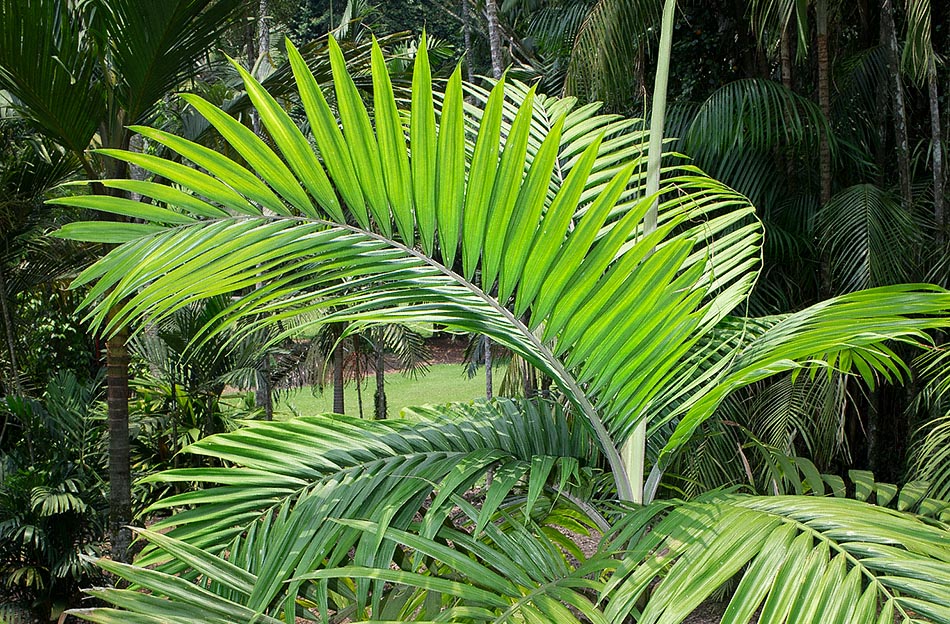
Burretiokentia hapala. Palms have two foliar models. The leaves can be palmate, shaped like a fan, or pinnate, like this one, comb like © Giuseppe Mazza
There are two basic foliar patterns from which derive the remaining ones. Stand out the palmate leaves, or fan-shaped, and the pinnate ones. The palmate leaves are formed by a petiole and by a margin that can be entire, like in Licuala grandis H. Wendl., or divided in segments, as in Chamaerops humilis L. or Washingtonia filifera H. Wendl.
If the leaves are fan-shaped, but have a hardened central ray, they are called costapalmate, it is the case of the Sabal palmetto Lodd. and some other species. The pinnate leaves, shaped like a comb or pinna, are formed by a petiole which unites the leaf to the stem and that elongates up to the extremity of the leaf, forming the rachis. This gets the shape of a branch to which unite the foliar segments or “pinnae”, determining the characteristic look of pinna or comb, like in Jubaea chilensis Baill., Phoenix dactylifera L., Phoenix canariensis Hort., etc.
Other possibilities are that they are doubly divided, and then they assume the name of bipinnate leaves such as Caryota urens L., or the leaves are not divided, entire.
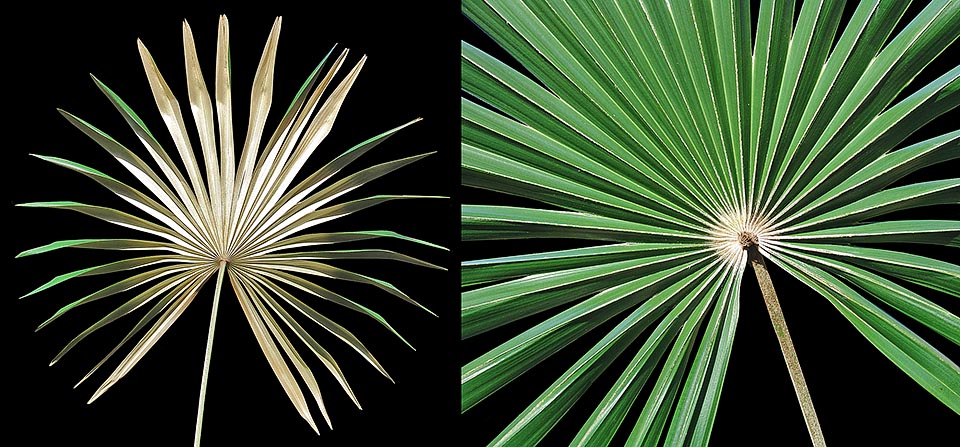
The leaves of the Guihaia argyrata are palmate, fan-like. We note a chromatic difference on both foliar sides, in this left case bronzy and light-bluishly on the right © Puccio
The new leaves generate from the centre of the foliar crown, with the look of vertical spears. With the increase in age they move to the base of the foliar crown, being pushed by the new leaves that require room. In this way, starting from the central part of the crown, we meet in succession young leaves, adult, mature and finally dry leaves, now dead and placed in the lowest part of the crown. The Phoenix dactylifera L. can produce 8 to 30 leaves per year. These last have an average life between 5 and 7 years. The total number of green leaves of a date palm may vary between 70 and 200.
It has been noted that many species of adult palms count only 10 to 30 leaves. The dimension of the leaves is an indicator for expressing a judgement on the physiological status of the palms. Usually the leaves produced by the young plants tend to be of inferior size. The crown of the palms is structured as to offer the least possible resistance to the wind. The leaf enjoys a great mobility and is provided with a developed and robust petiole that allows to absorb and to reduce individually the pressure of the wind. This, together with the spiral insertion and the wrapping position of the petioles that form the crown, contributes to the characteristic resistance of the palms to strong winds. Such structure reduces remarkably the effort done on the trunk.
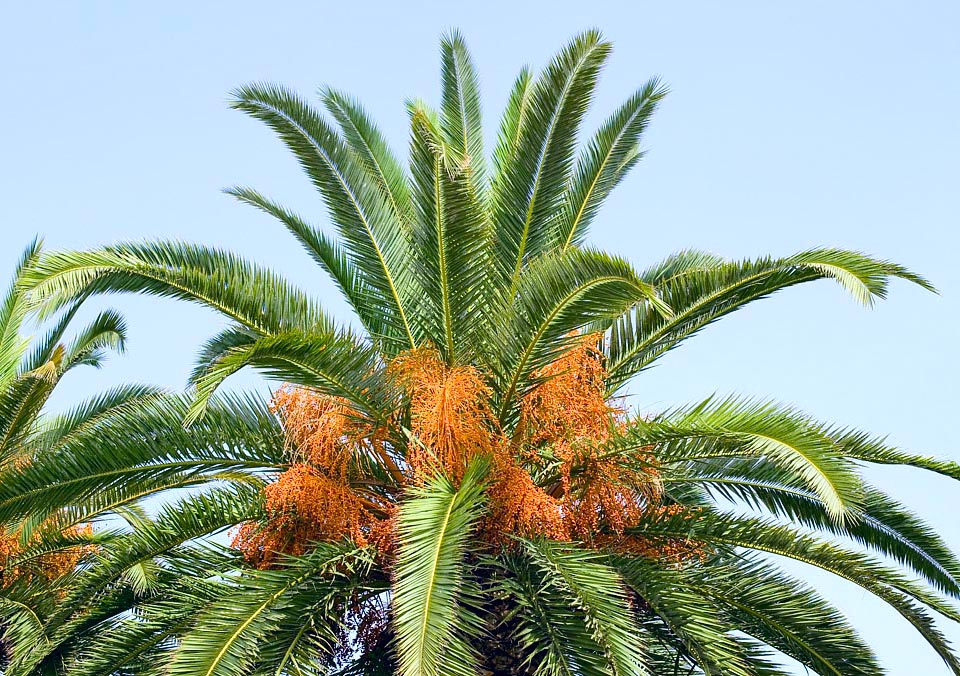
Crown with fruits of Phoenix canariensis. The new leave of the palms is born vertical at the centre of the crown and with time folds on the side supported by a solid petiole. Spirally arranged, they absorb and individually reduce wind pressure thus contributing to the characteristic resistance of the palms to hurricanes © Giuseppe Mazza
An aspect that usually draws the attention and reveals useful for the determination of the species is the colour of the leaves. Albeit the most frequent tone is of bright and glossy green, there are also various shades. In the landscaping area, very appreciated is the light blue colour, being this that most distinguished, such as of the Brahea armata S.Watson or blue hesper palm. We must say that these colourations are the consequence of the adaptations to the height, the luminosity, the type of soil, the aridity or the ecotype. Usually these reflections are due to the presence of waxy coverings, protective scales or as a response to environmental conditions.
A crucial factor, in relation with the conservation, the phytosanitary aspect and the pruning of the palms, is that the number of the leaves must be stable, even if every species had a different number. Also each single individual may have a different number of leaves, of course within certain limits. This observation leads to some considerations. The process of photosynthesis suffers few variations with all the green leaves in activity; we can say that it tends to the stability, as the palm has always the same number of leaves. In this way the growth will be the best, vigorous and healthy.
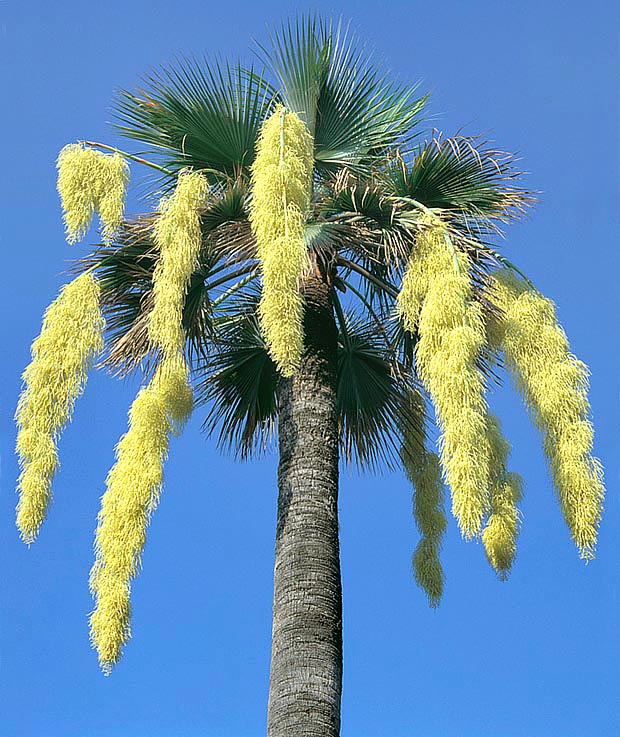
The spectacular perfumed inflorescences of the Brahea armata can be 6 m long © Giuseppe Mazza
If, for any reason, for instance through a pruning, we suppress some green leaves, we decrease the overall photosynthetic capacity of the palm and, consequently, we submit it to a process of weakening and of stress.
Flowers and inflorescences
The inflorescence of the palms is a spadix, simple or panicle ramified, with a more or less fleshy rachis, in which insert the flowers, protected by a sheath or a lignified spathe, closed, that wraps the whole inflorescence. When this opens it exposes the whole of the flowers to the exterior. The sheaths may detach naturally and, usually have a visible ornamental effect.
The inflorescences of some palms can get to measure more than 6 m of length and confer a huge ornamental value to the specimen, as is the case of the Brahea armata S.Watson. The flowers offer the main means of classification of the palms, as they present several distinctive elements: they can be bisexual, hermaphrodite, or unisexual and, normally, are arranged in verticils and in a very high number along the rachis.
The flowers of the palms are usually small and very numerous. The specimens of various species of Corypha L. get to have each one million flowers. Usually of green or white-cream colour, in some cases they are spectacular, like the lilac coloured flowers of some Archontophoenix or those golden yellow of the Butia capitata Becc.
The extremely delicate female flowers, usually have the property of being able to be fertilized only in the space of few days; they are pollinated by the wind or by insects, in particular by bees, dipterans and curculionids; they may emanate delicious fragrances as in the case of the Brahea armata S.Watson and of the Arenga engleri Becc.
In the palms may be present male and female plants (dioecious), as in Phoenix dactylifera L. and Phoenix canariensis Hort., or with both sexes on the same stem (monoecious), like for Syagrus romanzoffiana (Cham.) Glassm., Washingtonia filifera H. Wendl. and Washingtonia robusta H. Wendl.
The palms bloom when they have reached the maturity and this is achieved in a number of years variable depending on the species: from the three years of Chamaedorea elegans Martius, up to the 80 years of Corypha umbraculifera L. In this case it coincides with the death of the plant. The dates palm (Phoenix dactylifera L.) blooms annually, in spring, usually starting from 7 years of age. Due to the presence of different species of palms close together, are obtained numerous hybrids between species and genera that, hardly, would have generated in a natural environment. This is the typical case of the huge quantity of hybrids of the genus Phoenix.
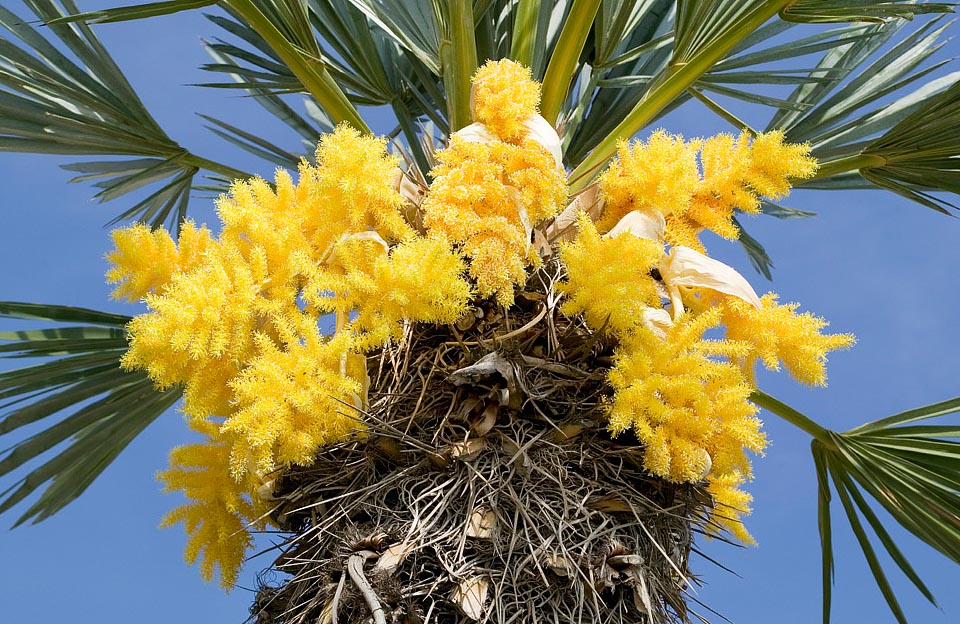
Trithrinax campestris. Few are the palms pollinated by wind. In most cases they attract insects with fragrant or unpleasant odours depending on the taste of the pollinators © Giuseppe Mazza
Pollination
Few are the palms pollinated through the wind. Among these we note Thrinax parviflora Sw., some species of Coccothrinax and the genus Phoenix. At the same time palms with very light pollen may be pollinated by insects, but also by the wind (Chamaedorea oblongata Mart. and Chamaedorea seifrizii Burret).
Original is the possibility that have some entomophilous palms to be pollinated, for a percentage of flowers, by the wind (Cocos nucifera L.).
Usually the flowers issue odours to attract insects and to favour pollination. These odours can be fragrant or unpleasant and at times loathsome, in function of the pronubes. The dipterans are usually attracted by odours that recall the putrefaction, whilst bees and vespids love sweet fragrances.
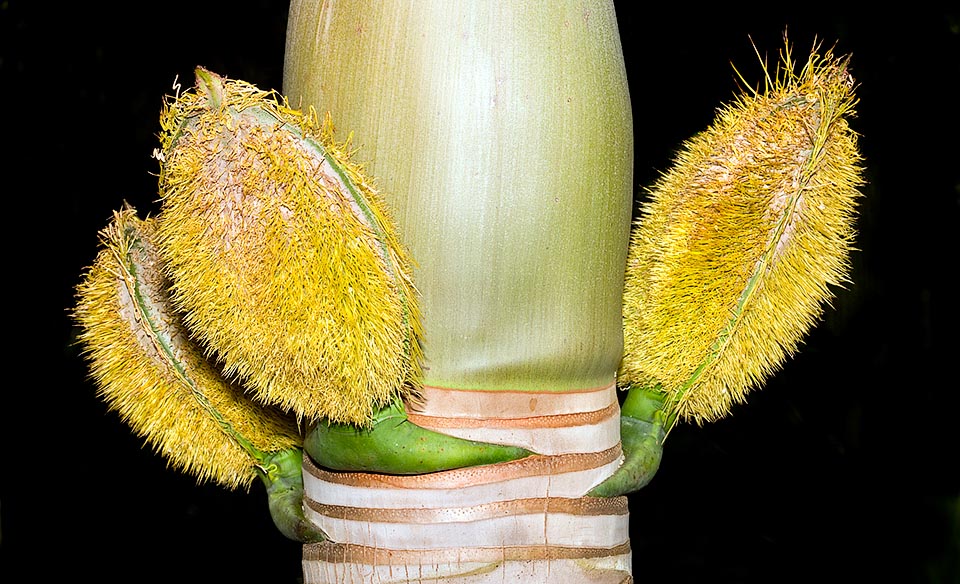
Spathes of Deckenia nobilis. The flowers of this palm are protected by a lignified, closed sheath wrapping the whole inflorescence © Giuseppe Mazza
Among the flowers of palm, in some species the fragrance limits to the male flowers (Leopoldinia piassaba Wallace), whilst in others flavoured both sexes (Cocos nucifera L.). Chamaedorea fragrans Mart. and Hyophorbe verschaffeltii H.Wendl. have flowers intensely perfumed. Particular is the sweetish scent of the male flowers of Phoenix dactylifera L. Other palms as Chamaedorea elatior Mart., Chamaedorea seifrizii Burret and Bactris gasipaes Humb emanate floral odours decidedly unpleasant, whilst those of Corypha are repellent. In some cases the odours emitted recall chemical substances such as ethyl acetate (Pinanga coronata Blume).
Fruits and seeds
The fruits and the seeds perform the function of dissemination and reproduction of the palms. The inflorescences, after the fecundation of the flowers, transform in infructescences, usually axillar and often have a precious ornamental value.
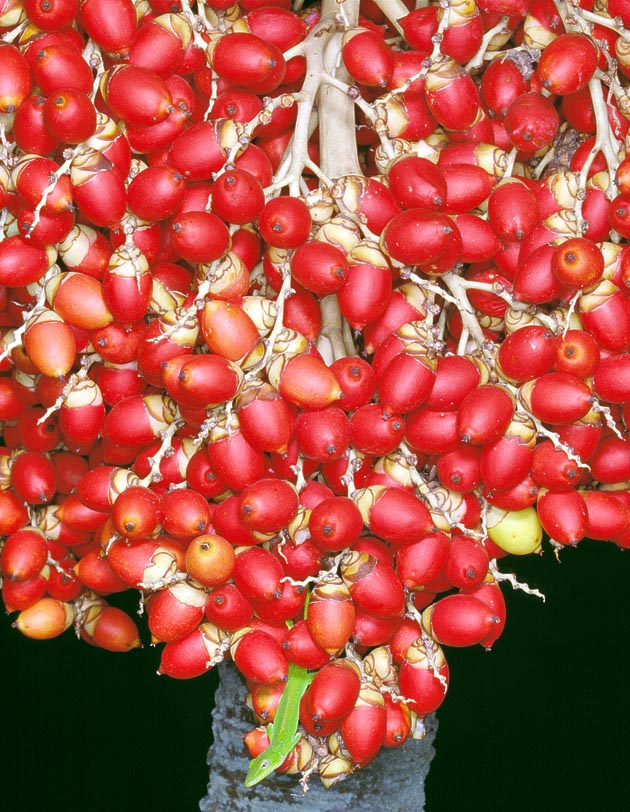
Adonidia merrillii. The fruits of palms, often more showy than flowers, are berries or drupes © Giuseppe Mazza
The fruits of the palms usually are berries or drupes, generally fleshy, and enclose the seeds. In some cases the fruits are more decorative and showy than the flowers.
A huge variety exists of forms, measures and colours, from the luminous light blue of Trachycarpus fortunei H. Wendl. to the bluish of the Livistona chinensis R.Br. up to the bright black of the Brahea edulis H. Wendl.
Many fruits of the palms are edible. The fruit commonly called date is usually formed by a fleshy part and by the seeds.
The fleshy part contains a great quantity of sugars, fibres, proteins, minerals and very few fats. Its caloric and nutritional properties may be similar to those of the honey (Phoenix dactylifera L.).
Usually they are wrapped by a coriaceous protection with the albumen inside that stores a huge quantity of reserve nutrients necessary for the germination and for feeding the small plant that will develop from the embryo.
Generally, the seeds do not maintain for long time their germinative power; therefore it is suggested to sow them as soon as possible.
Sowing is the most diffused system for the reproduction of the palms, but in some cases this may happen by separation of basal shoots. In some industrial cultivations recourse is done also to the multiplication “in vitro” of some varieties.
To realize a good sowing it is current technique to eliminate the pulp wrapping the coriaceous grain containing the seed.
The seedbed must be composed in equal parts of river sand and organic substance (free from peats), well decomposed. It is necessary to guarantee a stable temperature between 20 °C and 35 °C, depending on the species and a constant humidity, with a semi-shady exposition.
Dispersion of the seeds
The palms employ a great quantity of energy for producing seeds and performing the function of the reproduction and dispersion of the species. The dissemination is favoured through the gravity, aquatic currents and animals. In some instances are not rare the mutual relations between palms and animals.
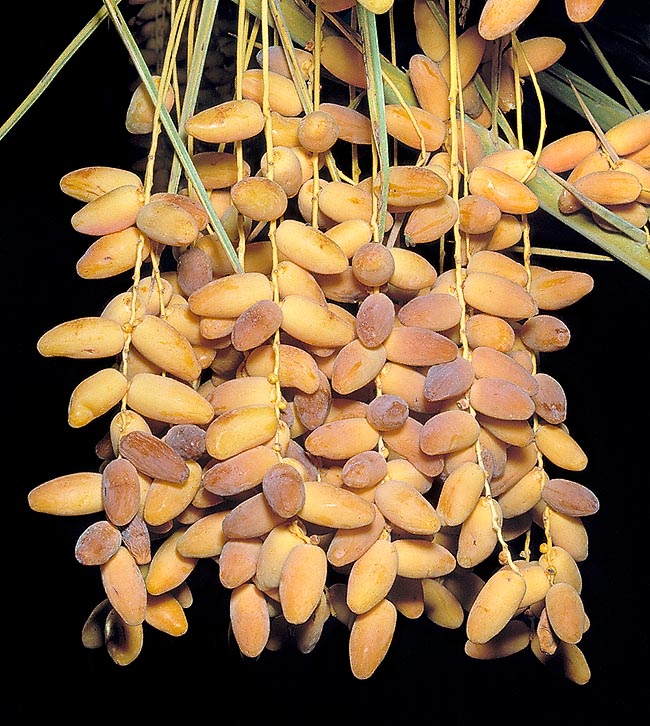
Phoenix dactylifera has dates with caloric and nutritional properties similar to those of honey © Giuseppe Mazza
Defense of the palms
The palms, during their evolution, have conserved a series of chemical and mechanical defenses to counteract the aggression of herbivores, phytophages and pathogens.
The chemical substances intended for the defense are “secondary”, as not directly involved in primary duties of growth, photosynthesis or reproduction and include nitrogen phenols, terpenoids and various compounds.
The tissues of the palms include also other compounds with defensive function, such as lignin, raphides and siliceous bodies.
These are natural compounds that render difficult the chewing and the digestion.
The pulp of some fruits contains small crystals (raphides) of calcium oxalate that are very irritant when ingested.
It is the case, for instance, of the genera Arenga, Caryota, Chamaedorea, Gaussia, Pseudophoenix and Wallichia.
Architecture of the plants
Growth models
The palms, like the other living organisms, respect architectonical models of growth prefixed, based on their own genetic laws and on the interactions with the environment where they develop. The determination of the growth models is based on a set of botanical variables: apical dominance, position of the inflorescence, type and direction of growth, etc.
From the combination of these variables generate the architectonical models or forms of the growth. It is an important method for analyzing the plants as it allows, inter alia, to foresee the evolutionary dynamics of each subject.
At least four architectonical models applicable to the palms do exist. They are the models of Holttum, Corner, Tomlinson and Schoute. Also other intermediate models or variants do exist.
Mono caulescent palms
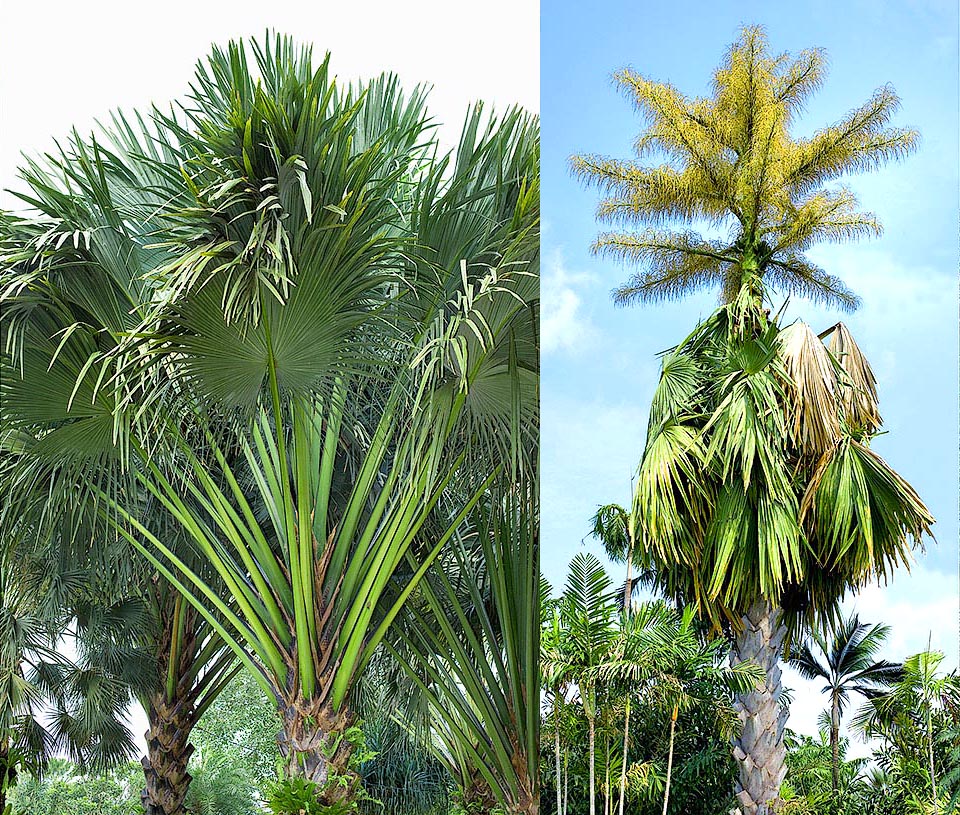
The Coryphale lecomtei is a monocaulescent palm that follows the so-called “Holttum growth model”. There is a first vegetative phase where the plant grows in height for years forming the stem, and a second one, reproductive, where the palm develops, sacrificing the leaves, a spectacular inflorescence and then dies © Giuseppe Mazza
Holttum model
Palms with single stem. In this growth model at least two phases are distinguished: a first one, vegetative, in which the plant grows in height forming the stem, and a second one, reproductive, in which the palm develops an apical or lateral inflorescence. After the fructification the palm dies. Examples: Corypha umbraculifera L., Corypha elata Roxburgh, Raphia regalis Beccari and Caryota urens L.
Corner model
Also this model concerns the mono-caulescent palms, with only one stem, not ramified. When the moment of the reproduction arrives the inflorescences may appear laterally or on the crown.
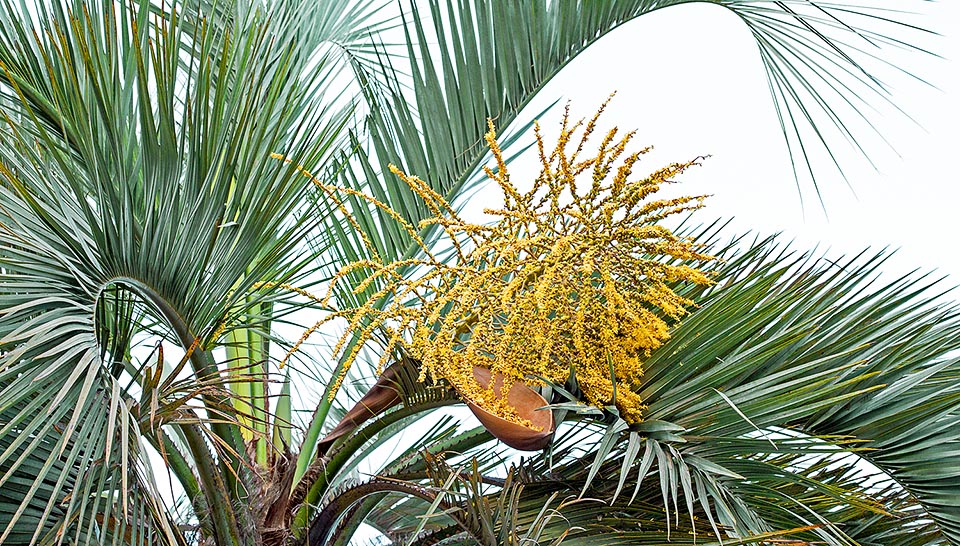
Also the Butia odorata is a monocaulescent palm but follows, as most cases, the “Corner growth model”. Once it has become adult it blooms but does not die © G. Mazza
However, the plant does not die after blooming. It is the most common architectural model among the palms with unique stem. Among others, concerns Trachycarpus fortunei H. Wendl., Phoenix canariensis Hort., Sabal palmetto Lodd., Syagrus romanzoffiana (Cham.) Glassm., Cocos nucifera L., Washingtonia robusta H. Wendl., Washingtonia filifera H. Wendl. and Jubaea chilensis Baill.
Multicaulescent palms – Tomlinson model
Palms with many stems growing from the base of the plant. Within this group are distinct different growth modalities. In most of the species the new stems grow in the perimetral area of the group whilst the oldest stems are located towards the central area. With time, the growth of these last reduces and appears less evident in respect to the youngest ones. To this group belong Dypsis lutescens (H.Wendl.) Beentje & J.Dransf., Chamaedorea microspadix Burret, Chamaedorea costaricana Oerst., Phoenix reclinata Jacq. and Rhapis excelsa H.Henry. Among the multicaulescent some species have a form of growth that characterizes them: some stems grow rapidly and dominate the group, whilst the others have a slower growth and form a dense foliar vegetation at the base (Phoenix dactylifera L. and Chamaerops humilis L).
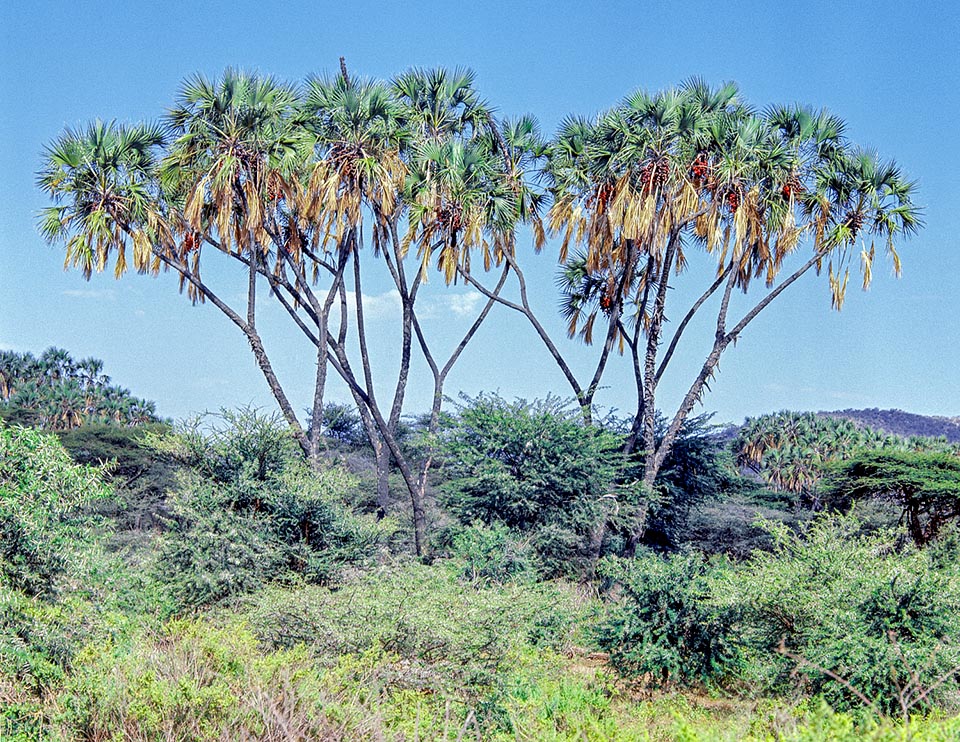
The Hyphaene thebaica is a monumental ramified palm of the African savannah following the “Schoute growth model” © Giuseppe Mazza
Ramified palms – Schoute model
The natural ramification in palms is rare and limited to few genera. This specification may originate from a phenomenon of dichotomy (bifurcation of apex growth) or by lateral ramification. In the case of dichotomy the bifurcation originates from the meristem of growth itself that divides in two parts and generates two new growth axes. Among these palms we find Hyphaene thebaica Mart. and Nannorrhops ritchieana Aitch. whilst in Nypa fruticans Wurmb the dichotomy is underground.
Characteristic is the Chamaedorea cataractarum Mart. whose growth in more stems comes from a division in depth of the thallus’ meristem, that determines with the time the separation in distinct individuals. The lateral ramification characterizes mainly species with underground stem, such as Allagoptera arenaria Kuntze and Serenoa repens Small. Cases of ramification exist due to damages to the meristem, with the growth of new lateral axes, even if normally one remains dominant.
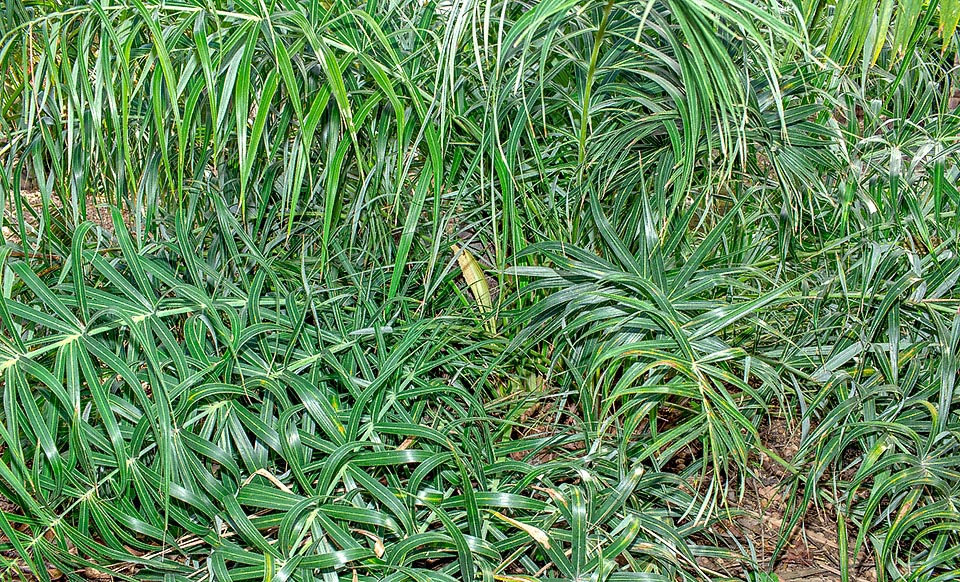
With its underground horizontal stem that grows on dunes close to the sea, Allagoptera arenaria is an acaulescent palm © Giuseppe Mazza
Acaulescent palms
These are slow-growing palms and with a very reduced stem. Usually they are palms that had to adapt to particular or extreme conditions of life, like droughts or fires. Typical are Allagoptera campestris Kuntze, Butia paraguayensis L.H.Bailey and Syagrus campylospatha Becc. that are part of the tropical savannah of the Cerrado in Brazil.
Usually the acaulescent palms represent the lowest level of the tropical forest. Some palms can have a stem partially underground as well as emerging: Sabal minor Pers. and Serenoa repens Small.
This family currently (2015) comprises the following genera:
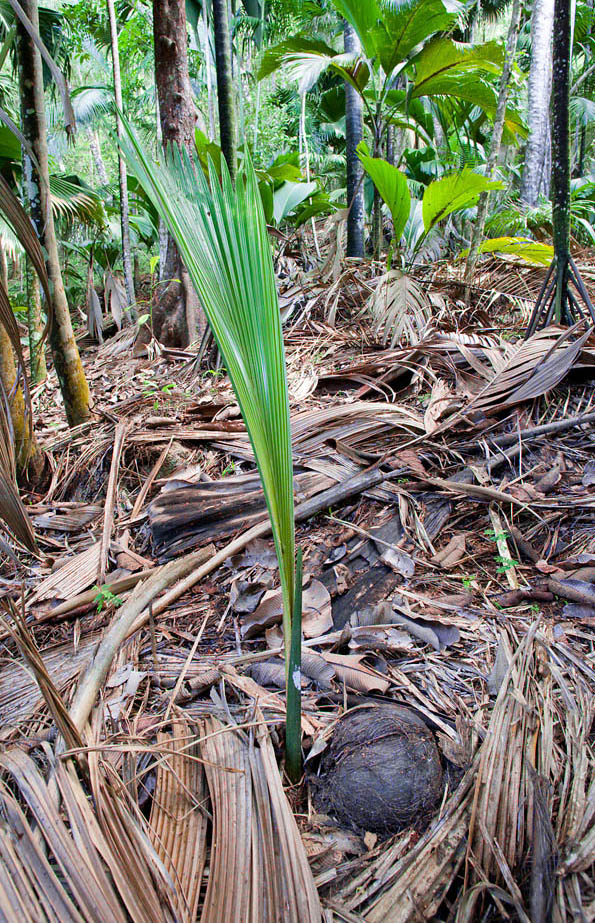
Germinating seed of Lodoicea maldivica in the Vallée de Mai at the Seychelles © Giuseppe Mazza
Acanthophoenix, Acoelorrhaphe, Acrocomia, Actinokentia, Actinorhytis, Adonidia, Aiphanes, Allagoptera, Ammandra, Aphandra, Archontophoenix, Areca, Arenga, Asterogyne, Astrocaryum, Attalea, Bactris, Balaka, Barcella, Barkerwebbia, Basselinia, Beccariophoenix, Bentinckia, Bismarckia, Borassodendron, Borassus, Brahea, Brassiophoenix, Burretiokentia, Butia, × Butyagrus, Calamus, Calyptrocalyx, Calyptrogyne, Calyptronoma, Carpentaria, Carpoxylon, Caryota, Ceratolobus, Ceroxylon, Chamaedorea, Chamaerops, Chambeyronia, Chelyocarpus, Chuniophoenix, Clinosperma, Clinostigma, Coccothrinax, Cocos, Colpothrinax, Copernicia, Corypha, Cryosophila, Cyphokentia, Cyphophoenix, Cyphosperma, Cyrtostachys, Daemonorops, Deckenia, Desmoncus, Dictyocaryum, Dictyosperma, Dransfieldia, Drymophloeus, Dypsis, Elaeis, Eleiodoxa, Eremospatha, Eugeissona, Euterpe, Gaussia, Geonoma, Guihaia, Hedyscepe, Hemithrinax, Heterospathe, Howea, Hydriastele, Hyophorbe, Hyospathe, Hyphaene, Iguanura, Iriartea, Iriartella, Itaya, Johannesteijsmannia, Juania, Jubaea, Jubaeopsis, Kentiopsis, Kerriodoxa, Korthalsia, Laccospadix, Laccosperma, Latania, Lemurophoenix, Leopoldinia, Lepidocaryum, Lepidorrhachis, Leucothrinax, Licuala, Linospadix, Livistona, Lodoicea, Loxococcus, Lytocaryum, Manicaria, Marojejya, Masoala, Mauritia, Mauritiella, Maxburretia, Medemia, Metroxylon, Myrialepis, Nannorrhops, Nenga, Neonicholsonia, Neoveitchia, Nephrosperma, Normanbya, Nypa, Oenocarpus, Oncocalamus, Oncosperma, Orania, Oraniopsis, Parajubaea, Pelagodoxa, Phoenicophorium, Phoenix, Pholidocarpus, Pholidostachys, Physokentia, Phytelephas, Pigafetta, Pinanga, Plectocomia, Plectocomiopsis, Podococcus, Pogonotium, Ponapea, Prestoea, Pritchardia, Pseudophoenix, Ptychococcus, Ptychosperma, Raphia, Ravenea, Reinhardtia, Retispatha, Rhapidophyllum, Rhapis, Rhopaloblaste, Rhopalostylis, Roscheria, Roystonea, Sabal, Salacca, Saribus, Satakentia, Satranala, Schippia, Sclerosperma, Serenoa, Socratea, Solfia, Sommieria, Syagrus, Synechanthus, Tahina, Tectiphiala, Thrinax, Trachycarpus, Trithrinax, Veitchia, Verschaffeltia, Voanioala, Wallichia, Washingtonia, Welfia, Wendlandiella, Wettinia, Wodyetia, Zombia.
→ To appreciate the biodiversity within the family ARECACEAE please click here.
